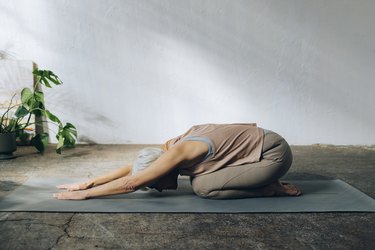
If you crave a satisfying post-run stretch but tend to lose interest after a few half-hearted toe touches, it's time to update your routine with purposeful, effective stretches that won't add much time to your workout.
To determine which running stretches are worthwhile and how to properly execute them, we spoke with Grayson Wickham, DPT, physical therapist and founder of Movement Vault, a stretching app and website.
Video of the Day
Why Is Stretching After a Run Important?
A post-workout stretching routine delivers myriad benefits for runners, Wickham tells LIVESTRONG.com, including better joint stability and range of motion. Stretching may also help prevent injuries by addressing muscle imbalances and improving proprioception (aka body awareness), he explains.
"Stretching won't fully eradicate your chances of getting injured, but it is going to decrease it," he says. "When you're doing active stretching, you're improving the mind-muscle connection," which, he explains, is often diminished by our daily activity, or lack thereof. "I even see it in people who are working out a lot and have been working out for years. We sit so much as humans. We're hunched over our desks, our phones, our books, and we're just not getting enough varied active movements in our days. We lose touch with certain muscles."
Stretching may also bolster recovery by "resetting" your nervous system after a long run or intense interval workout. There are two sides to the nervous system, Wickham explains. There's the sympathetic, which is associated with fight or flight, and that's basically what you're going to be in during most of your workout, he says. And then there's the parasympathetic, which is associated with rest and digestion.
"So, if you're doing some kind of post-run stretching and getting some good diaphragmatic breathing, that's going to increase your parasympathetic nervous system drive, which is going to be overall better for recovery," he says.
However, the type of post-run stretches you do matter. Wickham is a proponent of end-range isometrics, or active stretching, which differs from static or passive stretching. In passive stretching, you relax into a stretch and let gravity take over. "Active stretching is stretching out that muscle or joint and then contracting the muscles while they're maximally stretched out," Wickham explains.
So, for example, during a passive hamstring stretch, you may prop your foot up on a bench and bend over your leg. An active variation of that same stretch would also include a 10-second contraction of the hamstring, the muscle being stretched, by squeezing the hamstring for 10 seconds then releasing it. "When you're loading the joint while it's maximally stretched out, you're also sending an input to the nervous system to say, 'Hey, I'm safe in this position,'" Wickham says.
The Best 9 Stretches to Do After Running
Below are Wickham's top picks for how to loosen tight muscles after running, improve your range of motion and feel better in between runs. Perform one round of each leg stretch as a full-body mobility circuit, or choose a few cooldown stretch to incorporate into your current post-run stretch routine.
Things You'll Need
An exercise mat
Optional: a chair with a back
1. Active Bent-Over Single-Leg Balance With Hip Rotation
- From a standing position, lift your right leg behind you and bend forward at the waist so your right leg and torso are parallel to the floor. (If you need help balancing, rest your hands on the back of a chair or stable object of similar height.)
- Keep a slight bend in your left leg and drive your entire foot, including your big toe, into the ground for stability.
- Externally rotate your left hip as far as you can, then internally rotate it as far as possible. (Think about your hip as a door knob turning one way and then the other — only your hip should move.) That’s 1 rep.
- Perform 8 to 10 reps, then switch sides.
2. Segmented Cat-Camel
- Start on your hands and knees.
- Tip your pelvis forward and draw your navel toward your spine to round your back into a “cat” position.
- Slowly tilt your pelvis back and, one vertebra at a time, starting with your lower back and ending with your neck, move your spine into an arched “camel” position. Hold for 5 seconds.
- Flexing your upper back first, gradually round your back one vertebrate at a time until you’ve transitioned back into a cat position. Hold for 5 seconds. That’s 1 rep.
- Perform 2 to 3 sets of 5 reps.
3. Active Hamstring Stretch
- Start in a low lunge position with your right foot in front and your left knee on the ground.
- Lean forward and place both palms on the ground inside your right foot.
- Push your hips back and extend your right leg.
- Once you feel a deep stretch in your hamstring, contract your hamstring by digging your right heel into the ground. Hold for 10 to 30 seconds.
- Repeat 3 to 4 times, resting between reps, before switching sides.
4. Active Ankle Dorsiflexion Stretch
- Start in a low lunge position with your right foot in front and your left knee on the ground.
- Lean forward to deepen the bend in your knee and further flex your ankle. Make sure your knee tracks over your toes. Place your hands on the ground for balance and support, if necessary.
- Push your right foot into the ground and hold for 10 seconds. Then, pull up on your foot and hold for 10 seconds. (Think about punching on a gas pedal and then pulling your foot off of a gas pedal.) That’s 1 rep.
- Perform 3 reps, then switch sides.
5. Active 90/90 Stretch
- Sit on the floor with your legs extended in front of you. Bend your left knee and externally rotate your hip to rest your leg in front of you.
- Swing your right leg out to the side and bend your right knee. Both legs should form 90-degree angles, and your left shin should be parallel to your right thigh.
- Lean forward until you feel a deep stretch in your left hip.
- Push your left leg into the ground and hold for 20 seconds. Then, try to lift your left leg off the ground and hold for 10 seconds. (It won't go anywhere because you're in a maximal stretch, but you'll be activating the front side of your hip muscles in this shortened position.) That’s 1 rep.
- Perform 3 reps, then switch sides.
6. Full-Range Ankle Activation
- Sit on the floor, and, bend your right knee and place your right heel on the ground in front of you.
- Press your heel into the ground as you slowly rotate your ankle to the right, making a circle with your foot. Then, rotate your ankle to the left. That’s 1 rep.
- Perform 5 to 7 reps, then switch sides.
7. Active Runner’s Lunge
- Start in a low lunge position with your left foot in front and your right knee on the ground. Rest the top of your right foot on the floor.
- Lean forward slightly so that you feel a stretch in the right hip flexors and quadriceps.
- Lift the right knee off the ground. Think about kicking the top of your back foot into the ground, which will cause your quad and hip flexor muscles to contract while they are stretched out.
- Hold for 10 seconds, release the contraction, and lower the knee to the ground. That’s 1 rep.
- Perform 5 reps, then switch sides.
8. Tip Toe Squat
- Stand with your feet hip-width apart and lower into a deep squat by pushing your hips back and bending at your knees.
- Roll up onto the balls of your feet. (If you need help balancing, lightly rest your hands on the back of a chair or stable object of similar height.)
- Slowly lower your heels, but don’t allow them to rest on the floor. Then, maintaining the squat position, raise your heels as high as you can. That’s 1 rep.
- Perform 15 to 20 reps.
9. Thoracic Spine Rotation Hold
- Start on your hands and knees. Push your hips back so they’re resting on your heels. Lower down onto your forearms.
- Place your right fingertips behind your right ear and rest your right elbow on the ground.
- Keep your left forearm on the ground as you rotate at your spine to lift your right elbow toward the ceiling.
- Once you’ve reached the end of your range of motion for the rotation, hold for 10 seconds.
- Rotate the opposite direction to bring your elbow back to the ground. That’s 1 rep.
- Perform 6 reps, then switch sides.


